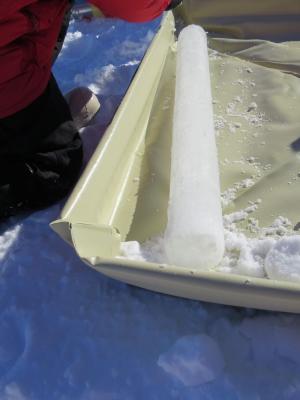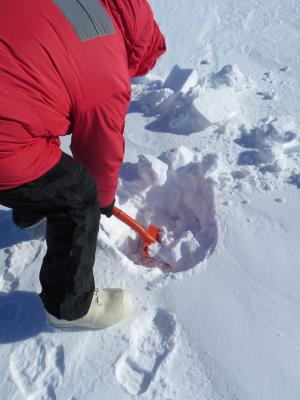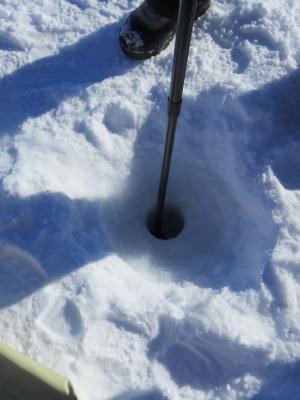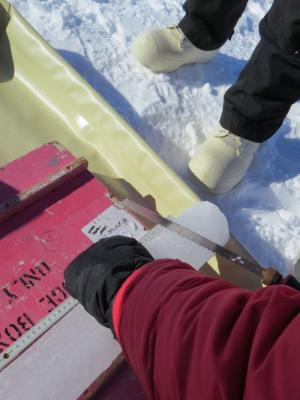This lesson is intended to help students make connections to polar science while discovering how and why sea ice drives deep ocean currents. Students will also learn key terminology related to sea ice and using actual salinity content charts, will graph a typical sea ice core’s salinity as it relates to depth.
Objectives
- Students will be able to identify and describe layers of sea ice.
- Students will be able to explain how and why the sea ice changes in salinity and how melting and freezing of sea ice drives deep thermohaline currents.
Lesson Preparation
- Preparation time is minimal and involves printing out and photocopying various worksheets and downloading videos and pictures and becoming familiar with the information.
- The teacher should also download ice core data from the Lesson Materials for this lesson plan.
- Also included in the Lesson Materials are videos of ice coring, background information on sea ice and worksheets.
- Teachers should also print out the student guides/worksheets.
- Photos from the field are included in the Resources section
Procedure
- Students should have a basic familiarity with ocean currents prior to this lesson. Introduce students to ice coring. A video of ice coring in the field is located in the resources section of this plan and can be downloaded for multiple viewings and may be a good intro.
- Discuss with students the various layers of ice one might encounter on a frozen sea. Have them draw a profile or print and photocopy the blank profile worksheet from the resources section and have them fill in the various layers.
- Have students predict what they think the salinity levels might be in a typical sea ice core and if the saline/brine content within a core is uniform from top to bottom. Students may struggle with prediction unless they understand that seawater is generally 3.5% or 35 parts per thousand (PPT), (35 grams salt per 1000 liters). Have the students write their predictions on the worksheet or on their diagram and have them justify their predictions.
- Provide students with a copy of the ice core data from the documents section. Have them graph the data. Discuss which variable would be independent and thus on the x-axis (depth of ice core) and which would be dependent and on the y-axis (saline content). Have students go back to their original predictions and determine if their predictions were accurate or not. Have them write in the correct salinity values.
- Have students complete the remaining questions on the worksheet by going on-line to the sites indicated on the worksheet. When complete, have students discuss in groups or as a class the implications of changing salinity in sea ice and how this creates movement (circulation) within the ocean.
Extension
The PIPERS project http://geotracerkitchen.org/pipers/ boasts additional information on sea ice production in the Ross Sea. Should students find interest in the topic, they may want to consider diving into the current research and in particular, the anomaly of why sea ice in the Ross Sea is growing/accumulating as opposed to melting as it seems to be elsewhere in the polar regions.
Resources
Site for the expedition to the Ross Sea, Antarctica (can be reached at: polartrec2017.com): https://www.polartrec.com/expeditions/seasonal-sea-ice-production-in-the-ross-sea
Information sites:
https://nsidc.org/cryosphere/seaice/index.html
http://www.pik-potsdam.de/~stefan/thc_fact_sheet.html
https://oceanservice.noaa.gov/education/tutorial_currents/05conveyor1.html




Assessment
- Students will be assessed on their completed worksheets and graph.
- Aspects of this lesson could be incorporated into summative assessments on ocean circulation.
Author/Credits
Jennifer Bault, 2017 PolarTREC Teacher
Nicolet High School
jenniferbault [at] nicolet.us
Lab Data:
Dr. Yongli Gao
University of Texas San Antonio
yongli.gao [at] utsa.edu
Dr. Hongji Xie
University of Texas San Antonio
Hongjie.Xie [at] utsa.edu
Dr. Pat Langhorne
Otago University, New Zealand
pat.langhorne [at] otago.ac.nz
Standards Other
Wisconsin Academic Standards for Science
ELS.C1.B.h Analyze relationships between parts of local and global natural and cultural systems.
ELS.EX2.A.h Identify and analyze limitations in our understanding of systems and the outcomes.
ELS.EX4.A.h Apply the laws of conservation of mass and energy to analyze cycles and flows of Earth’s systems, including: the cycling of matter and flow of energy among the biotic and abiotic components in the biosphere, atmosphere, geosphere, and hydrosphere; the transfer and loss of energy and mass at each link in an ecosystem; and the roles of photosynthesis, cellular respiration, and carbon sequestration in the global carbon cycle.
ELS.EX5.B.h Evaluate how feedback loops impact natural systems over time and predict adaptive strategies.
ELS.EN6.A.h Analyze the role of feedback loops in reinforcing the interconnectedness of parts within a system and the consequences of actions by each of those parts on the whole. Identify and analyze leverage points and cause and effect relationships within a system.
| Attachment | Size |
|---|---|
| Full Lesson: Sea Ice and Deep Sea Currents (PDF - 849 KB)849.39 KB | 849.39 KB |
| Lesson Materials (PDF - 631 KB)631.18 KB | 631.18 KB |
This program is supported by the National Science Foundation. Any opinions, findings, and conclusions or recommendations expressed by this program are those of the PIs and coordinating team, and do not necessarily reflect the views of the National Science Foundation.
